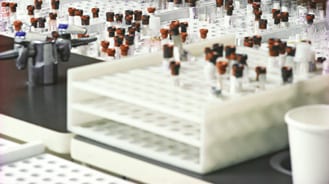Key points
- Laboratory personnel are at risk for melioidosis exposure when working with Burkholderia pseudomallei samples.
- Suspected melioidosis samples should be handled by trained personnel.
- Clinicians appropriately labeling samples and good laboratory practices prevent most B. pseudomallei sample-related accidents.
- Determine risk if exposed to B. pseudomallei and seek medical care if needed.

Overview
Prompt diagnosis and treatment of melioidosis are critical. Infection is confirmed by culture. Testing must be conducted by trained personnel because some automated identification methods in clinical laboratories may misidentify B. pseudomallei as a different bacterium.
Laboratory personnel who handle specimens from patients suspected of having melioidosis or cultures of B. pseudomallei are at risk of laboratory-acquired melioidosis. Some procedures required to prepare specimens for culture may aerosolize particles and release B. pseudomallei into the air, putting personnel at risk for exposure by inhalation.
In order to minimize high-risk exposures in diagnostic laboratories, work with cultures or isolates and aerosolizing procedures should be done with a biological safety cabinet (BSC). Once a culture is suspected of being B. pseudomallei, it should be transferred to a Biosafety Level-3 laboratory for further analysis.
Laboratory exposure
If a laboratory worker is exposed to B. pseudomallei, immediately wash and decontaminate the inoculation site (if there is one). Report the incident to the laboratory safety manager and perform a risk assessment to determine whether the incident is low risk or high risk.
If you're exposed in the lab
Laboratory workers who have been exposed to B. pseudomallei should monitor and record their temperatures twice a day for 21 days to look for fever. Workers who were exposed and become ill should seek medical care immediately. Symptoms might include:
- Fever greater than 100.4°F (38°C)
- Cough
- Progressive inflammation at the site bacteria got in through the skin
- Infection in other body parts or organs
The type of exposure determines the course of post-exposure management. Read more about post-exposure prophylaxis if it's warranted. Post-exposure management is summarized here:
- Post-exposure Management
- Begin post-exposure prophylaxis immediately
- Fever monitoring
- Begin post-exposure prophylaxis immediately
- Fever monitoring
- Fever monitoring only
Reporting results
If an organism is identified as or suspicious for B. pseudomallei, contact your state or local public health department immediately. The health department should facilitate forwarding the isolate for confirmation to the closest state laboratory or a Laboratory Response Network (LRN) laboratory. Staff at the state lab or LRN can facilitate sending presumptive positives to CDC for confirmation as needed.
CDC's Bacterial Special Pathogens Branch is available for assistance with:
- Detection and isolation
- Culture identification and genotyping
- Serology (limited to B. pseudomallei)
If an isolate is confirmed as B. pseudomallei, the state lab or LRN should forward the isolate to CDC for whole genome sequencing. Specimens should be shipped following regulations for Tier 1 Select Agents.
For urgent or technical clinical questions, contact bspb@cdc.gov or call the CDC 24/7 Emergency Operations Center at 770-488-7100.
